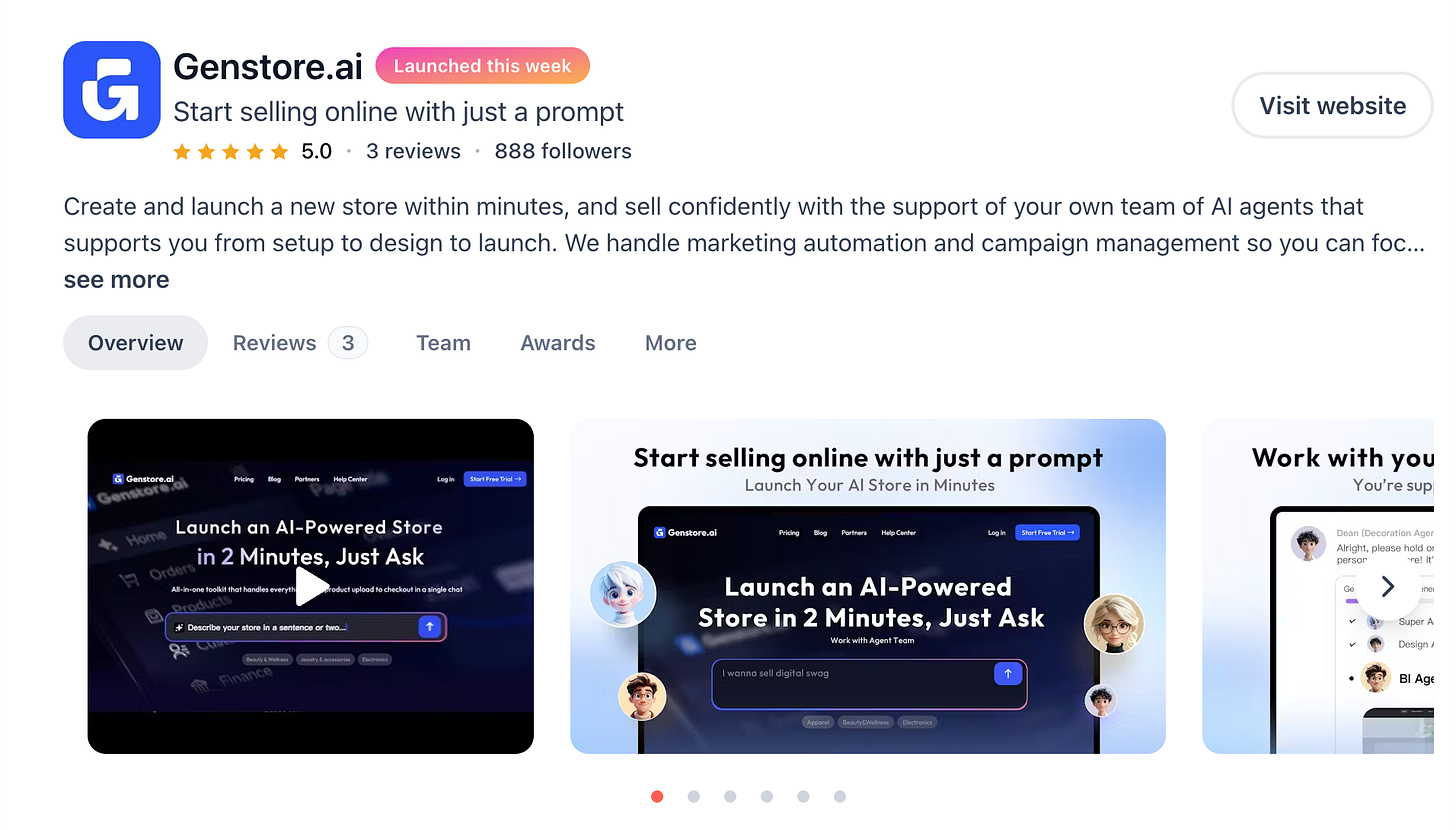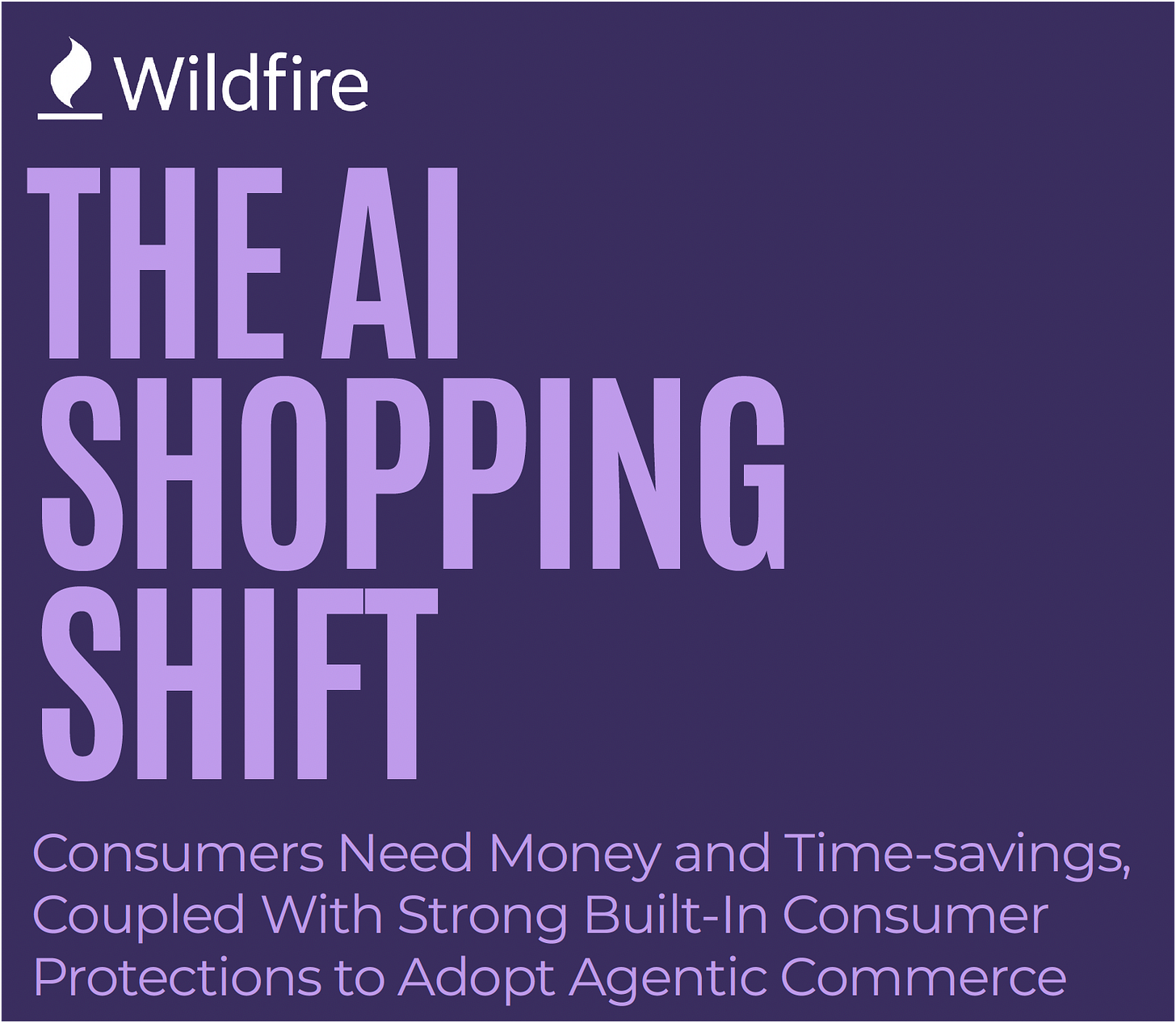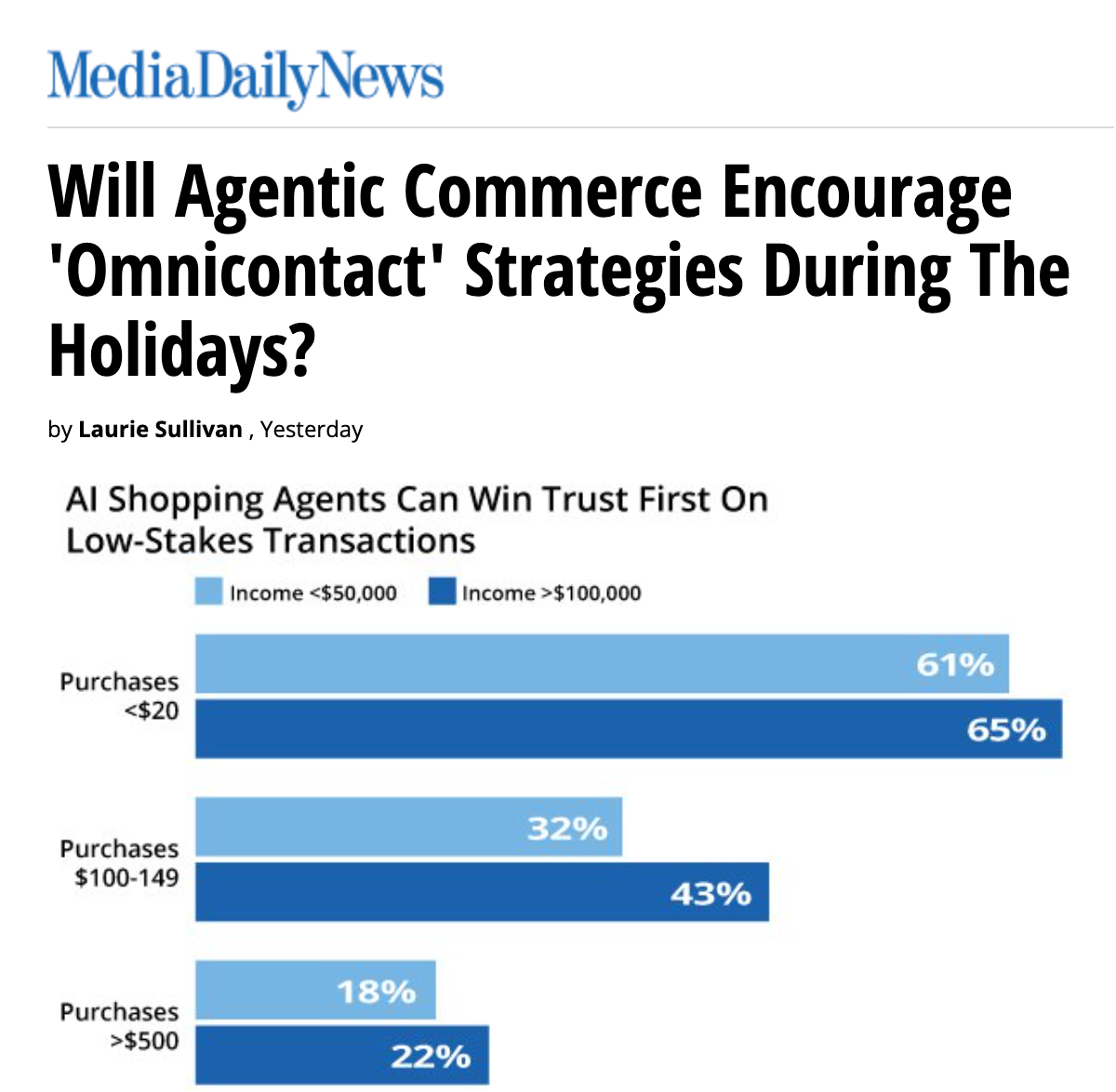Agentic Shopping News for the Week of 9/7-9/13 (week 37/52)
A Cool New Agentic Store Platform launches - could it be a Shopify Killer?, fresh survey data, and starting to think about how Agentic impacts BFCM in Holiday 25...
Usually the weekly news we cover in this series is ‘quick hits’ - a paragraph, maybe two about some news items, but this week I wanted to spend some time on Genstore.ai because there are two deeper Agentic Commerce concepts involved that I’ve been thinking a lot about and it is a great example for both of them. The first topic is ‘How will Agentic GenAI impact user interfaces?’ (this applies to any UI, but we use a lot of software in Digital Retail). The second topic is ‘What does Agentic GenAI or Agentic Commerce mean for Shopify?’. Before we jump into those side-quests, allow me to introduce you to Genstore.ai->
The First GenAI Agent-native Store Platform: Genstore.ai
I first learned about GenAI agents in Q4 2024 culminating in the Anthropic paper, “Building effective agents.” The ideas in here led me to decide to explore starting what would become ReFiBuy and Retailgentic.
When you are building something new with technology that’s also brand new, it can be very weird and ‘lonely’. By ‘lonely’ I mean in the context of you feel like you’re way out on this tiny little plank, until you get some customers, you have no feedback.
Here’s a concrete example. we decided to be ‘100% Agentic’ - meaning that our software builds on a variety of agents that do all the work of the software. This presents some interesting user interface questions.
For example, instead of a traditional SaaS interface, our engineering team works with the agents either through an ‘all agent’ chat session or through more of an interface that’s like a monday.com or ‘human’ project management platform, but the humans are our agents. (see it’s weird, I know I’m still wrapping my head around it).
In the early days we thought - ok we’ll just show that to customers - it’s wild! But my sense (and this was confirmed in our feedback) that is ‘too much’ and also there’s no real workflow meaning you have to make sure the user knows that the best way to use the achieve X is A→B→C→X.
Based on that feedback, we have a SaaS UI, but under the hood when you press the buttons in the SaaS app, the agents do their work behind the scenes. Over time, they will surface more and more as customers become more comfortable with this setup.
Product Hunt: Genstore.AI
That brings me to Genstore.ai - it popped on the scene out of nowhere on Product Hunt (where nerds look for cool new products - 99% not retail/ecommerce so probably not worth your time to sort through - that’s our job 😀).
Here’s the blurb of how they describe their product:
Create and launch a new store within minutes, and sell confidently with the support of your own team of AI agents that supports you from setup to design to launch. We handle marketing automation and campaign management so you can focus on selling.
Near and dear to my heart is this aspect:
This Agentic store will let you sell on TikTok, Instagram, Facebook and Amazon (and more).
GenStore.ai’s Skeuomorphistic Team of Agents
Interesting to this concept I spend a lot of time mulling over around Agentic interfaces, Genstore.ai is ALL IN on their agents. They give you a team of 8 agents all with different roles:
Genius - It’s the ‘Boss’ Agent (my words) - you can always start here if you need to. I imagine Genius will invoke other agents when needed.
Olivia - Campaign Agent - I think this will be of interest to ya’ll so splatting in here→ Olivia possesses strong market insight and full-funnel marketing campaign management capabilities, accurately capturing industry trends, conducting in-depth competitor analysis, and optimizing marketing strategies through data-driven decision-making. Olivia helps you stand out in highly competitive markets.
Dean - Design Agent - Dean has all the site templates, generates your first store and then helps you make tweaks as needed.
Luna - SEO Agent - Analyzes your site and competitors, collaborate with you on a plan and implements it.
Sara - Product Agent - You give it what you have about a product and generates a fully blown out listing.
Ella - Support Agent - Handles online support - chat, looking up order status, etc.
Harvey - BI Agent - This one’s probably my favorite - As a simultaneous user and builder of ‘dashboards’, I think I can say unequivocally they all basically suck. The piece of data you want is never there, you can never get your hands around what you need to know to take ‘action’ and ‘do something’ and ‘improve things’ or figure out the root-cause analysis, and solve things.
Inbox - Customer Service Agent - This agent is like Support agent, but for product-level questions. It can answer sizing questions and stuff like that.
That’s a lot to think about and you’re probably thinking - ‘‘ok that’s ‘cute’, but how does it actually work?” Conveniently they have given us a very tight video that shows the agents in action→ (90 seconds and well worth your time)→
Wacky Prediction: In 3 Years All Software Will Be Agentic and We’ll All Be Happier
It will take a while as all paradigm changes do, but I think in 2-3 years everyone in Retail Digital and other categories of software user will not only become comfortable with an Agentic UI, you will wonder why we did it the ‘old’ way to begin with. The first 💡moment when you realize how efficient it is. Instead of hunting through cascading menus and tiny icons trying to figure out what to press to do whatever you want to do - you just tell an agent and it delivers it.
Then, once you get comfortable with that, and trust them, you can setup the agents to trigger and do things related to each other. Now you’re only dealing with exceptions - the agents tried to answer the customer’s question, one has them stumped they raise it to you. The agents see a competitive opportunity to source ProductX, do you want them to source that? So on and so fourth - you spend 90% of your time on high-impact tasks and decisions vs today you are lucky to get 20% focus on that, in a larger org, maybe lower.
Genstore.ai gives you a little peak at what this could look like. But, what does it mean for Shopify?
Genstore.AI: Shopify Killer?
It’s way too early to call if Genstore is a Shopify killer, BUT I predict we’re going to have 100’s of these 100% Natively Agentic store platforms with different features, different market segments and approaches. The juiciest target for an entrepreneur in 2025 to take shot at is Shopify. SHOP enjoys a $185B market cap and a $9b+ revenue run-rate.
Why is Shopify a Juicy target for the Agentic Founder?
What many people don’t realize about Shopify is they are 30% software/SaaS revenues and 70% ‘checkout driven revenue’. By that I mean they make ‘hidden’ money off all the GMV flowing through their checkout- what I call the Shopify Checkout Hidden tax’. Every Tiktok store or Instagram post with that one-page Shopify checkout is paying a hidden tax (most don’t even realize) by using that checkout.
The Shopify tax and benefits of Agentic give Agentic-native stores the weakness and weapon to finally be a strong competitor to Shopify through a death by 1000 cuts strategy.
Let’s dig into that this as it’s important to undertanding what I think you’re going to see over the next 2-3yrs. The biggest pieces of the Shopify tax are:
The Shopify Checkout Hidden Tax:
Payment ‘mark-up’ or ‘kick-back’ - When you use the Shopify as your checkout, they use Stripe under the hood and mark that up. If you use Paypal, BNPL (Affirm, etc), or what-not, they either get a mark up or a kick-back or both. Every piece of the checkout makes Shopify $. Sure it maybe as low as .2% or whatever, but it rolls up to billions.
Shipping ‘mark-up’ or ‘kick-back’- Same as above - if you use Shopify’s USPS, UPS, FedEx, DHL or whatever system, they are either marking up the amount, getting a kick-back on it or both.
3PL - They mark up or take kick-backs (or both) on anyone using their 3PL network.
Shopify apps/store - Some of the most unhappy people in our ecosystem are sellers of Shopify apps - behind their friendly exterior, Shopify is quite rough on these folks - at some point this will boil over like Epic vs. Apple, it’s only a matter of time. If Amazon sellers are a 8/10 on the pain scale, Shopify app builders are hanging out at the Spinal Tap 11.
POS - For the physical retail they charge an even larger % of checkout.
I say ‘hidden tax’ because most of these are ‘blind’ (not super transparent, disclosed) to the merchant that hasn’t dug into all this - yes it’s transparent in their SEC filings, there is nothing illegal going on here, but Shopify is extracting $9B+/yr out of their merchant base.
This creates a huge opportunity that nobody has successful executed on for 10yrs - create an offering that’s as good as pieces of Shopify, but instead of taking a $9B hidden tax, pass that back to the user.
Shopify’s hidden take rate
To figure out Shopify’s ‘take rate’ at the highest level we can simply divide revenue by GMV over a similar period. For the full year of 2024 we have:
Revenue: $8.88b
GMV: $292.3b
Take Rate: $8.88/$292.3 = 3%
You could easily save each merchant half a point .5% to 1% which doesn’t seem like much, but it’s pure cost to the merchant and thus free margin.
Example: How Agentic Native Store Platforms, Like Genstore.ai, Can Pierce Shopify’s Armor
Let’s apply my theory to Genstore as an example. Their clever strategy seems to be geared towards the Shopify customer who is not focused on a transactional website, but primarily using Shopify to sell on ‘online channels’ like Instragram/TikTok (which is a material chunk of Shopify’s GMV). To carve off and win this user you need something that hits a couple of five key areas:
Easier - While Shopify has done a good job of avoiding some SaaS bloat, and they are piling agents on top of the SaaS bloat to feel modern, at some point you have to get into that and it’s a bit of a mess. Chatting with your team of 9 agents trained already on everything is much easier and gets you to the outcome faster - selling stuff efficiently and fast fast fast on Insta/TikTok.
Cheaper - I haven’t done the apples-to-apples comparison on this because Shopify’s pricing is tricky to parse, but IMHO to drive value Genstore needs to be less expensive than Shopify checkout by .5-1% and pass that on to the merchant. The $300 store credit is a great attention grabber and means you could spin this up and try it for your next 10 products with little to no risk.
Faster - Genstore shows they outperform ‘the top store platform’ on site speed and build, etc. The agents make you fast - I have these 10 skus I want to get on tiktok now - go. Time that against the trad SaaS flows. Faster to build, faster to operate, faster to add products
Leaner - These types of businesses run on tight tight margins.
Innovative - Agentic is a breakthrough and new paradigm that allows you to achieve the above when they couldn’t have been done prior to 12/24.
The more of these areas you can hit the better chance you have. Based on what I can tell Genstore.ai hits on 4/5.
We’ll be keeping a very close eye on Genstore and sharing the other platforms coming as the release and keep you updated on it.
Now back to our usual weekly recap format!
Wildfire - New Survey Data
Wildfire systems is a loyalty and rewards provider is out with new survey data. The firm surveyed 1,000 US consumers and has a comprehensive report based on the data that came out this week (provided via the download button below). The highlights:
78% of people increasingly interested in Agentic Shopping tools
Value is an increasingly important shopping consideration for consumers
83% plan purchases carefully and do more comparison shopping
20% are "very comfortable" letting an AI agent find products, confirm prices, and place orders for everyday purchases
Concerns around AI agents include data privacy (49%), unwanted subscriptions (44%), overspending (41%), and incorrect product selection (38%)
Consumers are willing to share low-stakes personal information with agents, like clothing/shoe size (43%), preferred brands (40%), and purchase history (33%) to enhance personalization - resulting in better agent/user alignment
Time-saving is also important: 34% said saving time would encourage agent use, 27% cited research efficiency, and 25% cited faster checkout
Get GEO Nerdy With Me: What Can We Track and What’s Missing? (spoiler: not much and a lot!)
The traditional SEO publications are starting to run more and more GEO content. Most of it is super high level and not related to Agentic Commerce. While this piece is super horizontal and not commerce related, a common question I get as people start digging into GEO is around measurability and this piece does a great job of describing in detail what you can measure and what you can’t today. Unfortunately if you are used to the Google traffic hose, it’s not as much data as you are going to want. It also has some good ideas on how to analyze what you can measure:
Some of these are implementable in your current web traffic analytics programs like Google Analytics.
Agentic Shopping Panel with a Whopping 10 Person Panel - Your BFCM Task List for Agentic Shopping
I was skeptical when I saw the 10-box, but this ended up being a great panel. It’s a bit technical going into CDNs, firewalls, Cloudflare and all the other infrastructure elements that keep a modern Digital Commerce site running and humming, but today many of them are blocking friendly shopping agents trying to buy from you.
If you want to save ~45mins, here’s the takeaways.
AI shopping agents are rising and often get treated like bots, causing good orders to be blocked. (Bonus: If you’re reading the three part series - this is the main cause of Pitfall 1!)
On top of that: Perimeter/edge tools (e.g., WAF/CDN) are tightening on AI traffic; some models obfuscate, which looks fraud-like.
If the agent can get through, the credit card companies don’t see agents as any additional risk/don’t block are even welcoming (see all the news from Visa/MasterCard/PayPal/etc) — assume normal merchant risk.
Run your own agent against your site to see where it breaks (perimeter → checkout → payment). *YES* There’s a pod coming on this 😉
Add “know-your-agent” telemetry: input/event entropy, headers, IP/ASN, headless hints; bucket as human/bot/agent-unknown.
Align Marketing × Fraud pre-BFCM: report ROAS net of fraud by channel and reallocate spend accordingly.
Tune rules for social/video commerce (TikTok/IG) where fingerprints look risky but buyers are legit.
For high-touch deliveries, use address intelligence (business/residential, freight forwarders) and encode locale/voltage blocks.
They end up with a great BFCM (Black Friday/Cyber Monday) Agentic checklist:
Make sure your production environment is agent friendly
Load test your fraud infrastructure to make sure is bot friendly.
Use an anti-scalper tool for product drops vs. catching agents in DDOS
Build a war room to make sure you respond quickly if something is blocking good-agents and also to deal with bad actors.
Work with IT to make sure you have a Web Application Firewall that is Agentic Shopping Friendly.
Will Agentic Commerce Drive Omnichannel this Holiday?
Media Daily News had an interesting piece asking the question: “Will Agentic Commerce Encourage ‘Omnicontact’ Strategies During the Holidays?
In the piece they source a lot of the same data we’ve discussed to get to their conclusions.
It’s a Wrap: Coming up on Retailgentic
This week we’re out at RetailClub and Shoptalk, but don’t despair, the content will be rolling out this week:
Tuesday we have a surprise to share we’re excited about
Thursday we have an amazing podcast
Next weekend I hope to be able to quick-turnaround a RetailClub Highlights post to show you what the show was like, share the ‘hallway conversation’ topics and more!
Come keep the discussion rolling here→










